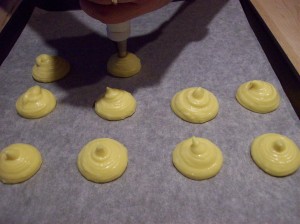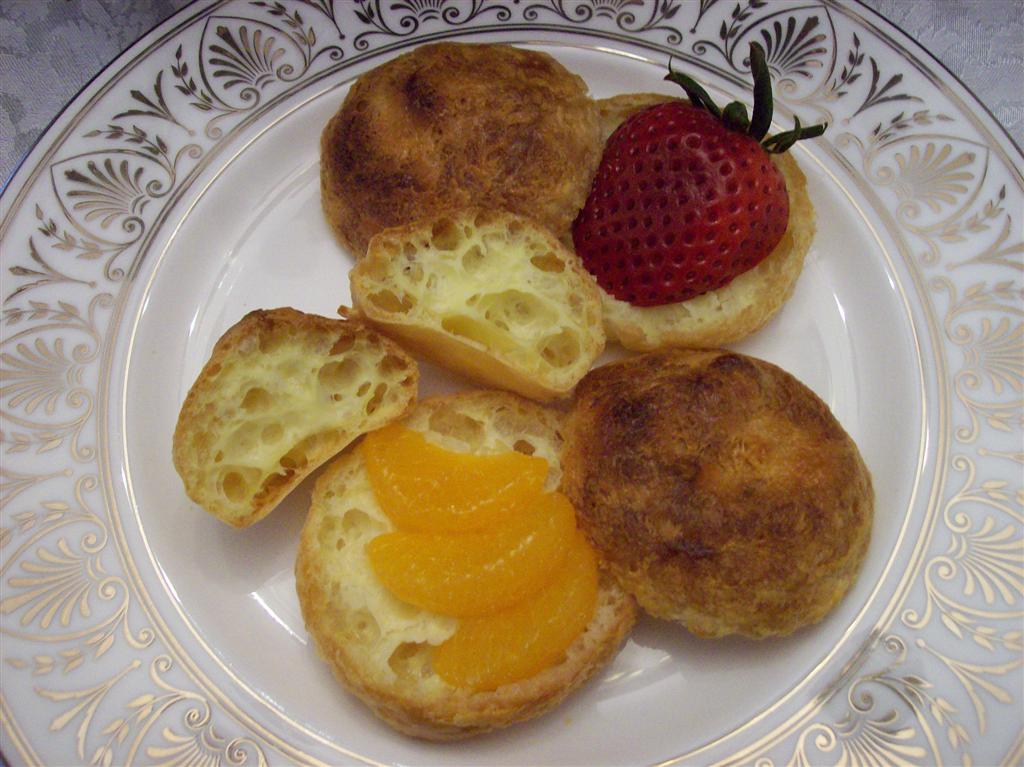I think it was in a Szechuan Chinese restaurant where the listÝfirst began.Ý After a bite of a particularly spicyÝserving of mapo doufu (spicy bean curd), I grabbed my glass of water, downed about half of its contents and, after reducingÝthe fire on my tongue to a mere smolder, turned to my wife and remarked, “Water has to be one of the world’s greatest inventions!”.Ý Thus, my list of the World’s Greatest Inventions was born.
Now before I getÝcomments pouring in, pointing out thatÝwater isn’t strictly an ‘invention’, I ask that you bear with me and allow me the latitude to use the word ‘invention’ in the broadest possible sense.ÝÝWhy the requested forbearance?Ý Because my list ofÝthe World’s Greatest Inventions includes inventions, discoveries, natural resources… well, you get the picture.Ý And what does all this have to do with goug¡®res?Ý ÝGoug¡®resÝhappen to beÝmade with two ingredients that are on myÝWorld’s Greatest Inventions list; water, #2Ýon my listÝand cheese, #4Ý(anyone care to guess what #1 and #3 are?).
Goug¡®res, thoseÝlight-as-air French-style cheese puffs, makeÝan idealÝhors d’oeuvre or appetizer when having guests over for dinner or a party.Ý They are quick and easy to prepareÝand require only a few simple ingredients.Ý Goug¡®res are made from a very fluid, egg and butter enriched dough called p¡¢te ¡Ý choux.Ý Leavening is accomplished not by yeast or chemical leavening agents but byÝthe steam that is produced within the dough during baking.Ý It is for this reason thatÝit is very important to whipÝas many small airÝbubbles into the p¡¢te ¡Ý chouxÝas possible during its preparation.
The recipe presented hereÝwas modified considerablyÝfrom that presented in LarousseÝTraditional French Cooking by Curnonsky.Ý Because I enjoy a more substantial, lessÝcreamy centerÝtoÝmy goug¡®res, I’ve omitted the small amount of heavy cream in the original recipe.Ý For the same reason, I’ve substituted water for the originally specified milk.
P¡¢te ¡Ý Choux
- 105 g King Arthur Organic Select Artisan Flour
- 105 g Butter
- 265ÝgÝWater
- 4 Large Eggs
- 80 g Gruy¡®re Cheese (grated)
- 1/8 tsp.ÝSalt
To a medium saucepan is added the water, butter and salt.Ý The saucepan is heated until all the butter is melted.Ý Using a whisk, the ingredients are whipped until a homogeneous mixture is obtained.Ý The flour is then added all at once and the brisk whipping continued until all the flour is incorporatedÝand a shiny dough is formed.Ý After incorporation, the whipping is continued on the heat for another 2-3 minutes.
After this time, the dough is removed from the heat, transferred to theÝbowl of a stand mixer (although the following steps can be done by hand, if so desired), and allowed to coolÝtoÝroom temperature.ÝÝUsing a whisk attachment, the dough is whisked at speed 6 while slowly adding the eggs, one at a time.Ý Each egg isÝallowed to fully incorporateÝwithin the dough before the next egg is added.Ý One half (40 g) of the grated Gruy¡®re cheese is then added and the whisking is continued until a light and fluffy dough is obtained, aboutÝ2 minutes.
Using a pastryÝbag,Ýthe resultingÝp¡¢te ¡Ý choux is then piped into small mounds onto two, parchment paper lined bakingÝsheets as shown below:

The remaining 40 g of gratedÝGruy¡®re cheese is then sprinkled on top of theÝp¡¢te ¡Ý chouxÝmounds and the goug¡®res are baked in a pre-heated 400∫F oven for 15-17 minutes, until brown.Ý After browning,Ýthe oven heat is turned off,Ýthe oven door is propped open so that it is slightly ajar, andÝthe goug¡®resÝare allowed to sit in the oven for an additionalÝ5-10 minutes.Ý This willÝallowÝthe goug¡®res to firm up and maintain their structure.Ý The goug¡®res are then removed from the oven and served either warm or at room temperature.

I’m a bit of a p¡¢te ¡Ý choux fan, myself! But I’ve never made goug¡®res. They are wonderful little goodies to pop in to your mouth when they are well made. Yours look “yummy”… ha ha ha! Jane
I will try this recipe tomorrow, it looks wonderful. Is there any chance you can post the ingredient volumes as well as their weight? This would help.
Jane, I used to think of p¡¢te ¡Ý choux as being suitable solely for sweet pastry, such as ¡©clairs, but it was a pleasant surprise for me to learn that it works wonderfully well for savory items as well.
Coleen, I measure all my ingredients by weight rather than volume because of the inherent imprecision in volume measurements, so unfortunately I can’t give you the ingredient volumes. Perhaps one of the many weight/volume conversion charts found on the web might be of help to you.
If I may, I would add that the butter should be cut and not be added to the water in one big piece. If left in one large piece, the butter takes much longer to melt and much of the water would evaporate (boil away).
Love gougeres and yours look great – but where’s the list? ;-}
Your goug¡®res are beautiful (but a French would never eat one with fresh fruits, it’s only eaten with salty other dishes/fillings or plain!). I remember the ones my mom used to bake, she served them for dinner with a chunky (homemade) tomato sauce, mmm. I also remember tiny gougeres the restaurants of Burgundy (I lived a few months near M¡¢con, 60 kms North of Lyon) served as apetizers, wonderful! Thanks for that little trip in my memory and f¡©licitations Steve, you did a great job! I should bake some for my girls, they would love it.
Claire46, thank you for the tip.
Patsy, your comment is much appreciated. Perhaps more of the World’s Greatest Inventions will be revealed in future posts. üôÇ
Flo, you caught me! I had originally planned to pair the goug¡®res with a nice savory duxelles but realized, at the last moment, that I hadn’t any mushrooms. Since fruit and cheese is a classic combination, I decided to try it here. Although not de rigueur, the slight saltiness of the goug¡®res worked surprisingly well with the sweetness of the fruit.
Number 1…… wine?
Number 3…. chocolate?
üôÇ
Sally,
As they say on the inside of soda caps… Sorry, try again! üôÇ
(Funny how chocolate is on just about every women’s list but on very few men’s lists)
Goug¡®res are an ideal little appetizer and yours look delicious. But like Flo, I was surprised by the fruit. üôÇ But indeed, why not, when you think of it?
Well, interestingly enough, I don’t care for chocolate myself. Well, I should rephrase that, I like it, but it would not be on my list.
At the risk of being banned from every reputable food blog or forum in the known universe, I confess that I love WHITE chocolate
(sorry)
üôÇ
still curious about your list, though. Foie gras? (that one makes mine for sure!)
Sally, no reason to feel sorry. I, too, prefer white ‘chocolate’ over actual chocolate. As for my list, the #3 slot is filled by bacon.
Steve, your Goug¡®res look wonderful! I’ll have to give these a try.
One question about baking. Would the dough stand for a delay of 30 minutes or so while the first batch baked or would the air migrate to the surface and ruin the open crumb?
Eric, the p¡¢te ¡Ý choux is fairly stable and should maintain its integrity for 30 minutes. Since the goug¡®res are baked on two baking sheets, why not put both sheets in the oven at the same time, one on a rack positioned just above the other?
Hi Steve, Greetings from Hong Kong!
We are salivating over your bread pictures.
Claire46 Says:
If I may, I would add that the butter should be cut and not be added to the water in one big piece. If left in one large piece, the butter takes much longer to melt and much of the water would evaporate (boil away).
—————-
The above interpretation is why people are afraid of baking…
It’s also false – the water won’t boil until the butter reaches the same temperature… science.
Since butter melts at a lower temperature than water boils….. you can add it all in one big chunk!
Please don’t add unnecessary steps and procedures to what should be a simple and easy recipe.
Bake MOAR!!!
Hi Steve, tried doing it 3 times but –
1st. try, the goug¡®res bottom stick to the parchment paper and the final dough is very fluid.
2nd. try, 60% of it stick to the parchment paper but this time the dough is on the heat for 6 mins. and after it’s bake the center are hollow.
3rd. try, I reduce the eggs qty. to 3. The final dough is sticky to feel but the goug¡®res center are still hollow and glad that all of it didn’t stick to the parchment paper.
I have been using Gold Medal unbleached good for bread flour and going to do it with the remaing cheese this week. How do you then get the final product as shown?
So what I did is fill it with lemon custard and taste good.
Lien, p¡¢te ¡Ý choux is a very loose dough. In fact, I would be more inclined to call it a very thick paste rather than a dough. It is the addtion of the eggs that gets it to this consistency. To insure that the final p¡¢te ¡Ý choux is not too fluid, you need to be sure that enough water is driven off during the heating and whipping stage prior to cooling and the addition of eggs. Regarding the goug¡®res sticking to the parchment paper, you might want to check your oven to make sure that it is not heating to a higher temperature than that to which it is set.
Hi Steve,
Thanks for the prompt reply!
pueden ser con otro tipo de queso que no sea gruyere ??
nicoo, gruy¡®re is the cheese that is traditionally used when making goug¡®res, but I would imagine that any sharp, smoothly melting cheese would also work fine.
Steve,
I have learned! Therefore this was not a complete waste of my time. I did not wait for the dough to cool to room temperature as I was in a hurry this evening.
During the egg addition instead of the dough becoming firmer, it became more liquid. The final result was so runny it was unusable.
I added some flour to stiffen it up and still the results were less than ideal – they looked like baked pancakes! üôÅ To be honest the best ones were the ones that I burnt, they tasted like goldfish. (I used sharp cheddar as that was what was in the house.)
I shall try again in a couple of days, any insight or words of wisdom you would like to share prior to that will be welcome.
Kind Regards,
Tom
Tom,
Adding eggs to the flour mixture will, indeed, loosen the mixture. The ‘dough’ used to make goug¡®res is more of a very thick batter than a conventional bread dough (see the Piping Goug¡®res photo above). The goug¡®res should puff up when baked, similar to the baking of a souffl¡©.
Buenos dias Steveb, he llegado hasta aqu¡≠ a trav¡©s de un libro que me regalaron, y mi sorpresa fue cuando vi de que se trataba, poco a poco empiezo con el mundillo del pan, as¡≠ que espero coger muchas ideas de tu blog, un saludo desde Barcelona.
Buenos dias Marisa,
Un saludo desde Boston!
#1 wine? your website is inspiring me to make my own bread, thank you!